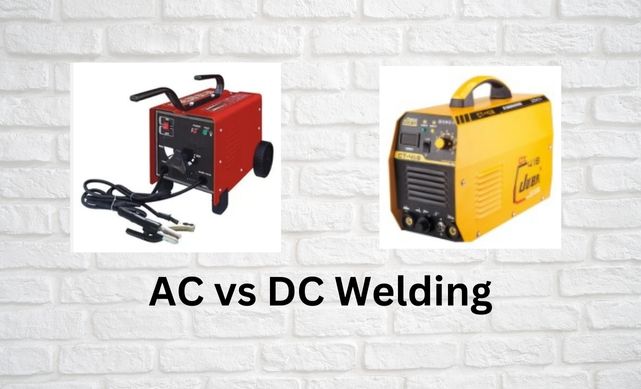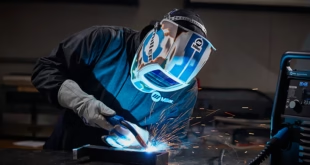AC vs DC Welding
Introduction
Welding is a fabrication process that joins two or more pieces of metal or thermoplastics by applying heat, pressure, or both. The process involves melting the base metal or filler material to create a joint that is as strong or stronger than the original material. This article will explain AC vs DC Welding.
AC (Alternating Current) and DC (Direct Current) are two different types of welding currents used in welding. AC welding is typically used for welding aluminum and magnesium, while DC welding is used for welding steel and other materials. DC welding is further divided into two types: DCEN (Direct Current Electrode Negative) and DCEP (Direct Current Electrode Positive). DCEN is used for welding thicker metals, while DCEP is used for welding thinner metals.
Choosing the right welding process is crucial to achieving a high-quality weld. The type of metal being welded, the thickness of the metal, and the desired weld joint all play a role in selecting the right welding process. Using the wrong process can result in poor-quality welds, increased costs, and safety hazards.
AC Welding
AC welding is a type of welding process that uses an alternating current (AC) power supply to generate the electrical arc needed for welding. AC welding is commonly used for welding materials with high thermal conductivity, such as aluminum and magnesium.
Advantages of AC welding include the ability to weld materials with a high thermal conductivity, such as aluminum and magnesium, and the ability to weld materials with a lower melting point, such as thermoplastics. AC welding also provides a cleaner weld due to the self-cleaning action of the electrode.
Disadvantages of AC welding include the potential for arc instability and the need for a high-frequency current source to start and maintain the arc. AC welding can also result in a lower quality weld if not done correctly.
AC welding is suitable for applications such as welding aluminum and magnesium, as well as for welding thermoplastics. It is also commonly used in applications where a clean weld is desired, such as in the food and beverage industry.
Examples of welding processes that use AC welding include tungsten inert gas (TIG) welding and plasma arc welding. TIG welding uses a tungsten electrode and a separate filler material to create the weld, while plasma arc welding uses a plasma torch to generate the arc.
DC Welding
DC welding is a type of welding process that uses a direct current (DC) power supply to generate the electrical arc needed for welding. DC welding is commonly used for welding thicker materials, such as steel and stainless steel.
Advantages of DC welding include a more stable arc and better control of the welding process, resulting in higher quality welds. DC welding also provides greater penetration of the base material, making it better suited for welding thicker materials.
Disadvantages of DC welding include the need for a more complex power source and increased costs compared to AC welding.
DC welding is suitable for applications such as welding steel and stainless steel, as well as for welding thicker materials. It is also commonly used in industrial applications where high-quality welds are required.
Examples of welding processes that use DC welding include shielded metal arc welding (SMAW), gas metal arc welding (GMAW), and flux-cored arc welding (FCAW). SMAW, also known as stick welding, uses a consumable electrode coated in flux to create the weld. GMAW, also known as MIG welding, uses a wire electrode and a shielding gas to protect the weld from contamination. FCAW is similar to GMAW, but uses a flux-cored wire instead of a solid wire electrode.
AC vs DC Welding Comparison

AC and DC welding differ in the direction of the electrical current used in the welding process. In DC welding, the electrical current flows in one direction, either negative (DCEN) or positive (DCEP), while in AC welding, the current alternates between positive and negative directions.
In terms of electrode polarity, AC welding uses a non-directional electrode, while DC welding uses either a positive or negative electrode depending on the polarity chosen.
In terms of arc stability and penetration, DC welding generally provides a more stable arc and greater penetration than AC welding. AC welding, however, is better suited for welding materials with high thermal conductivity, such as aluminum and magnesium, due to its ability to maintain a self-cleaning arc.
In terms of weld quality, both AC and DC welding can produce high-quality welds when done correctly. However, DC welding is generally preferred for applications where high-quality welds are critical, such as in the aerospace and nuclear industries.
Examples of applications where AC welding is preferred include welding aluminum, magnesium, and other materials with high thermal conductivity. AC welding is also commonly used in the food and beverage industry where a clean weld is desired.
Examples of applications where DC welding is preferred include welding steel and stainless steel, as well as thicker materials where greater penetration is needed. DC welding is also commonly used in industrial applications where high-quality welds are required.
Both AC and DC welding have their advantages and disadvantages, and the choice of which to use depends on the specific welding application and material being welded.
Safety in AC and DC Welding
AC and DC welding processes both have safety considerations that need to be taken into account.
In AC welding, the electrical current alternates between positive and negative directions, which can create a higher risk of electrical shock if safety precautions are not followed. In addition, AC welding produces higher levels of ultraviolet (UV) radiation, which can cause skin burns and eye damage if proper protection is not worn.
In DC welding, there is a risk of electrical shock if safety precautions are not followed, but the risk is generally lower than in AC welding. DC welding also produces lower levels of UV radiation, but still requires proper protection to prevent skin burns and eye damage.
To ensure safety in both AC and DC welding, it is important to follow proper safety procedures, such as wearing appropriate personal protective equipment (PPE), grounding the welding equipment, and ensuring proper ventilation in the welding area. It is also important to ensure that the welding equipment is properly maintained and inspected to prevent electrical hazards.
Both AC and DC welding can be done safely by following proper safety procedures and using appropriate PPE. The specific safety considerations may differ between AC and DC welding, but the importance of following safety procedures and ensuring proper equipment maintenance and inspection is critical for both.
FAQs
What is the difference between DC welding and AC welding?
DC welding and AC welding differ in the direction of the electrical current used in the welding process. In DC welding, the electrical current flows in one direction, either negative (DCEN) or positive (DCEP), while in AC welding, the current alternates between positive and negative directions.
Is steel welding AC or DC?
Steel welding can be done using both AC and DC welding, but DC welding is more commonly used for welding steel.
Is DC welding safer than AC?
Neither AC nor DC welding is inherently safer than the other. However, proper safety precautions must be taken regardless of the welding process used.
What is AC welding used for?
AC welding is commonly used for welding aluminum and magnesium.
Is MIG welding AC or DC?
MIG welding can be done using both AC and DC welding, but DC welding is more commonly used for MIG welding.
Which metal is suitable for AC welding?
AC welding is suitable for welding materials that have a high thermal conductivity, such as aluminum, magnesium, and copper.
Is AC better than DC?
Whether AC or DC is better depends on the specific welding application. AC is better suited for welding materials with a high thermal conductivity, while DC is better for welding thicker materials.
Why is DC preferred over AC?
DC is preferred over AC for welding because it provides a more stable arc, better control of the welding process, and greater penetration of the base material.
What are the disadvantages of DC welding?
The disadvantages of DC welding include the need for more complex equipment and increased costs.
Why is DC welding preferred?
DC welding is preferred for its advantages in stability, control, and penetration.
Is DC more harmful than AC?
Neither DC nor AC is inherently more harmful than the other. However, welding should always be done with proper safety equipment and procedures.
Is 6013 welding rod AC or DC?
6013 welding rod can be used for both AC and DC welding.
Is AC welding safer?
AC welding is safe when proper safety precautions are taken.
Which gas used for AC welding?
Argon is commonly used as a shielding gas for AC welding.
What temperature is AC welding?
The temperature for AC welding varies depending on the specific welding application and material being welded. It is important to follow the recommended welding parameters for the specific application.
Conclusion
In conclusion, the choice between AC and DC welding depends on various factors, including the material being welded, the thickness of the material, and the desired quality of the weld. AC welding is better suited for materials with high thermal conductivity and for applications where a clean weld is desired. DC welding, on the other hand, is better suited for thicker materials and for applications where high-quality welds are critical. Both AC and DC welding can produce high-quality welds when done correctly, but the specific welding process used and the electrode polarity chosen can affect the stability and penetration of the arc, and ultimately the quality of the weld. Therefore, it is important to choose the right welding process for the specific application to ensure a successful weld.
 Welding of Welders All about Welding and Welders
Welding of Welders All about Welding and Welders



